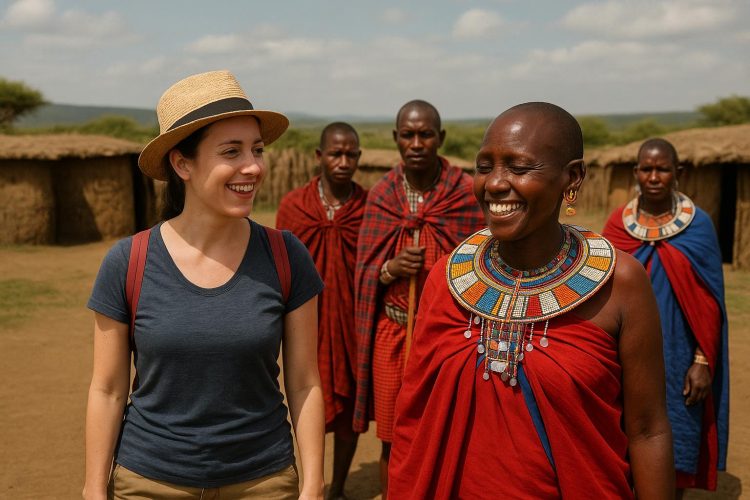Introduction to Maasai Villages
The Maasai are a semi-nomadic ethnic group residing in Kenya and Tanzania, known for their unique culture, traditional attire, and distinctive lifestyle. Visiting a Maasai village provides an opportunity to experience their way of life, interact with community members, and learn about their customs and traditions.
Accessing a Maasai Village
Maasai villages are typically located in rural areas, away from urban centers. Travelers can access these villages through guided tours often organized from nearby towns or lodges. These tours offer a structured approach to exploring Maasai culture, ensuring that visitors can delve deeply into village life. It is advisable to book tours with reputable operators to ensure a genuine experience and support ethical tourism practices. Reputable tour operators not only provide insight into cultural nuances but also ensure that a portion of the tourism revenue is channeled back to improve the local community’s welfare. This ethical approach to tourism ensures that the Maasai lifestyle is preserved while adapting to modern influences.
Cultural Etiquette and Interaction
Upon arrival at a Maasai village, visitors are usually welcomed with traditional songs and dances. The rhythmic chants and vibrant costumes create an inviting atmosphere that symbolizes the Maasai’s warm hospitality. As guests immerse themselves in this cultural experience, they are encouraged to engage respectfully. It is important to ask for permission before taking photographs and to respect personal space and customs. Conversations with Maasai elders and community members can provide insight into age-old traditions that have been passed down through generations. Understanding these traditions enriches the visitor’s experience and fosters mutual respect between cultures. Observing and participating in daily activities with a mind open to learning can bridge cultural gaps and enhance the overall interaction.
Village Structure and Daily Life
A Maasai village, or manyatta, typically consists of several huts arranged in a circular fashion, with an enclosed area for livestock. This layout not only provides security for the community’s cattle but also facilitates communal living. The huts are constructed using locally sourced materials such as mud, sticks, grass, and cow dung. These materials are environmentally friendly and demonstrate the Maasai’s resourcefulness and adaptability to their environment. Daily life in a Maasai village revolves around livestock, which is the primary source of sustenance and economic livelihood. Cattle are prized possessions and play a crucial role in social and economic transactions, including dowries and settling disputes. Maasai women are skilled artisans, creating intricate beadwork and decorations that are both functional and symbolic. These daily interactions and communal activities form the social fabric of Maasai life, placing a strong emphasis on cooperation and collective well-being.
Learning Opportunities
Visitors can learn about the Maasai’s traditional practices, such as cattle herding and beadwork. Observing or participating in traditional herding techniques offers insights into the skills passed down through generations. Some tours also include demonstrations or workshops where visitors can participate in activities like bead-making or traditional rituals. These activities are not just recreational; they are educational opportunities that illustrate the Maasai’s craftsmanship and cultural expression. Additionally, this is an opportunity to learn about the Maasai’s challenges in maintaining their traditional ways amidst modernization pressures. Discussions often cover topics such as land rights, education, and the impact of climate change on pastoral lifestyles. Engaging with the Maasai on this level allows for a deeper understanding of their resilience and adaptation in the face of external pressures. For more information on how to plan a visit, you can explore official tourism websites like Magical Kenya or regional travel guides that provide insights into Maasai cultural experiences. These resources offer valuable tips on how to prepare for a cultural visit that is respectful and rewarding.
Supporting the Maasai Community
Engaging in community-based tourism initiatives ensures that the benefits directly reach the Maasai people. Community engagement fosters development that aligns with the Maasai’s values and needs, thus ensuring sustainability. Purchasing handmade crafts or contributing to local projects is a way to support their economy. Many Maasai communities have set up cooperative initiatives, allowing artisans to showcase and sell their crafts to visitors. This transaction not only supports the artisans’ livelihood but also helps preserve the Maasai’s unique artistry. It is crucial to choose tours that prioritize sustainable and respectful interaction with the Maasai community. Sustainable tourism practices minimize cultural disruption and environmental impact while maximizing economic benefits for the host community. Through responsible tourism, visitors can contribute positively to Maasai society, ensuring that this rich cultural heritage is preserved for future generations. In conclusion, a visit to a Maasai village is more than a cultural excursion; it is an opportunity to build bridges between worlds, enhance cultural understanding, and contribute to the well-being and preservation of a timeless way of life.
